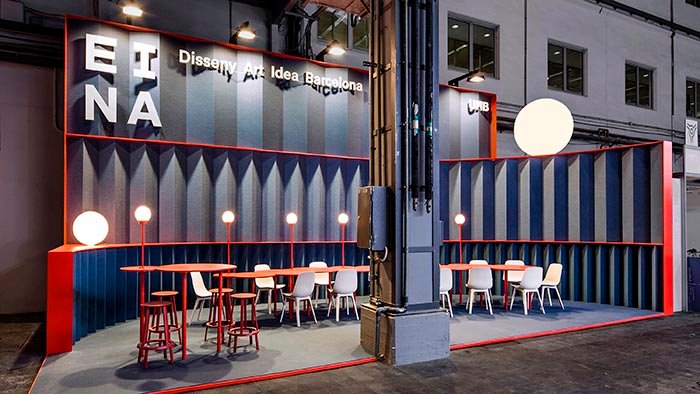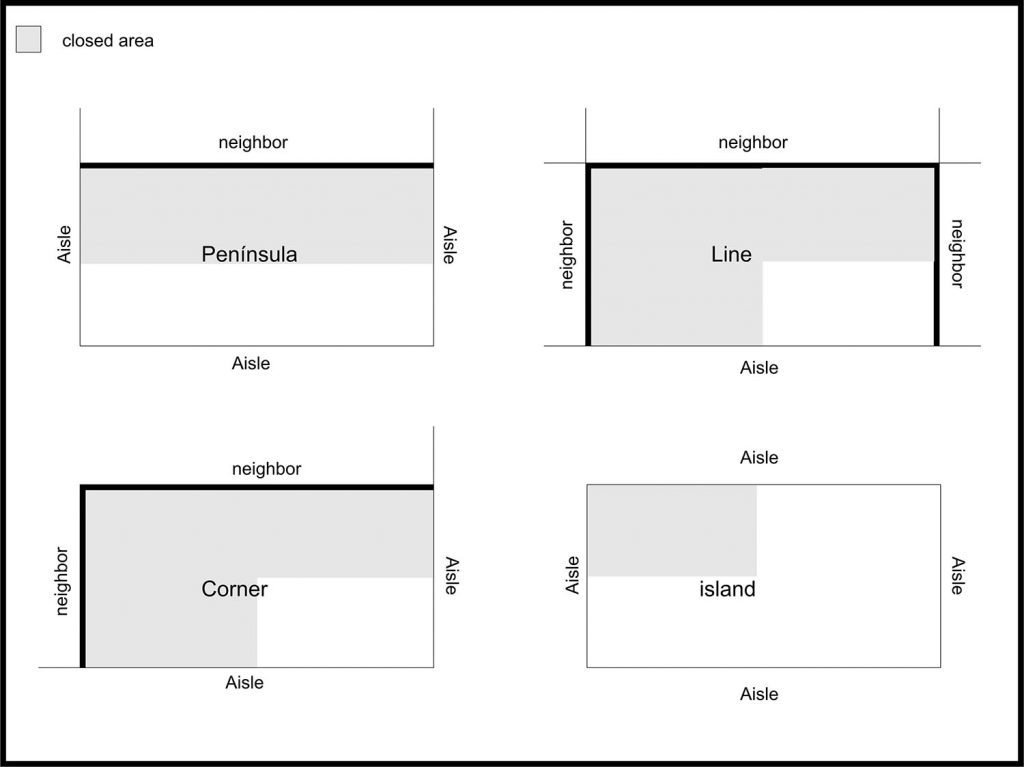How to choose the space of your stand? Don't lose visibility
Even if you exhibit for the first time, you will realize that the spaces offered to you are not the best, these are usually already reserved by the exhibitors at the end of the last fair.
If you have got a good space in the pavilion, try to book it immediately for the next edition. This will give you priority and seniority at the fair, which means having a more visible space every time you exhibit.
Next I will talk about the different variables that you should consider to determine that you have a good or bad space:
A- Pillars of the fair in your space:
If you have already participated in a fair and have had a pillar pavilion, you would like to contract a space without it. It impedes the visibility of your brand and is always a problem for the design of your stand. But it is true that most stands with a pillar… are cheaper. Here's how you can take advantage of what at first seems like a handicap.

Normally, an attempt is made to cover the pillars of the fair with carpentry. The fairgrounds do not allow gluing anything to the pillars and there must be a 20 cm gap. Another problem can be that the pillars include fire hose installations that cannot be covered, as in the following case.
In this case, the fair pillar has been used to support an aerial volume. By covering the pillars, columns can be created where to place the mark in height. .

B- Pavilions: choose to be with your competition or with your industrial sector
There is little use waiting for buyers from your sector to visit if you go to another sector and the pavilions usually group stands from the same sub-industry. Consult with the people of your sector in which pavilion they exhibit so as not to be left out.

C- The better the place in the pavilion, the better the result of the fair.
If you have visited the pavilion of a fair, you will know that after three hours walking around you will consider going to the other side of the fair to see a supplier. Provide your potential customers with access to your stand, placing you as far as possible on the main streets. On the other hand, you must strategically choose the place, based on the location of your competitors and the most important companies within the pavilion. If you approach the largest ones, you are more likely to capture potential customers than in the sector with smaller stands. .

D- Choose a space that allows you visibility
You also have to look at the position of your stand. Does it face the main street? Is it rear facing? How will you make sure that your brand is seen from any point of the fair? Here is an example of good and bad places within a pavilion and some design possibilities to improve its visibility.

excellent location
- It has the circulation of the two most important ships of the pavilion.
- It is next to the largest stands of the pavilion.
- Allows access from all four sides
- Unlike its neighboring stands, it does not have any exhibition pillar.
regular connection
- You have your back to the fair, a tall billboard won't be very visible.
- Being close to the central part of the pavilion and large exhibition stands does not make it a bad location.
Good location
- It is the first stand that is seen when entering the pavilion through the central street;
- Almost everyone who enters the pavilion passes through this booth.
bad location
- It is located in the last corridor of the pavilion.
- Has height/lift restrictions
- He has his back to the whole fair
- You have your back to the fair, a tall billboard won't be very visible.
D- Repeat location gives you privileges.
If the space they have given you is profitable, try to hire it immediately for the next edition. This youYou will be given priority and seniority at the fair, which will allow you to have a more visible space each time you exhibit.

E- Verify that your space is suitable for your stand idea
Do you have an idea of the design or layout of your stand? Check that the pavilion and the space that you have been assigned or chosen allow your design. We explain many of the factors to take into account:
- Height allowed in the pavilion: Do you plan to place a suspended sign? There are pavilions that do not allow it, and there is also a weight restriction for suspended structures. It usually ranges from 50 kg per suspension point to 250 kg. The first case only allows an aerial element without a light structure, while the 250 kg allows hanging wooden structures, light structures, etc.
- Do you want to make a private sector inside your stand? Depending on the size of your space you can do it, but keep in mind that although the regulations of each fair vary, it is not usually allowed to close one street more than 50%. That is why you have to think a little about the circulation and the basic scheme of your stand before saying "yes" to the space.
- Do you think that everything you need will fit in your stand? It is a good idea, before commissioning a design, to make a small outline, with a grid. You can do it by hand on a napkin at a bar. It's enough to get an idea of the possibilities. It will also help you when passing the brEafing to the company that designs your stand.
How to take advantage of all the spaces, even the most complicated ones!
This is a diagram of the different types of spaces. The gray areas are the ones that are normally allowed to build (the other areas usually have low walls, up to 1m high). You will see that depending on the configuration and size of your space, there is or is not the possibility of adding spaces to the stand.

Let's see some of the advantages and disadvantages that each type of space can have...

Online stands (1 side)
Usually the cheapest space, it places you between two stands that can affect your visibility depending on the height at which they rise.

Stand in Peninsula (3 faces)
You share the back of your booth with the neighboring booth. This type of stand (as in the linear one) has the advantage that it allows you to use the back of the stand to place closed office and storage areas. You will have a greater influx of public since you use the circulation of 3 streets;

Corner stand (2 faces)
Here you have two streets and the possibility of directing totems and markers towards two different places in the fair.

booth on island
It is the queen of the fair, with 4 aisles you have optimal circulation (always depending on which part of the pavilion we are talking about) an island at the end of the pavilion does not guarantee much. The bad thing is that depending on the size of the island, it will be difficult for you to close the streets to make private areas.
Don't miss the next chapter of this exciting adventure!
I hope this information has been useful and helps you choose the space for your stand at the next fair. Now that you have an idea of the types of stands and their parts, it is time to go into more detail and learn about their finishes. This is what I will explain in the next post.






